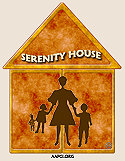Serenity House Family Residence ~ An Apartment With A View
SERENITY HOUSE FAMILY RESIDENCE
a temporary haven for survivors of domestic violence
 Serenity House Family Residence is the African American Planning Commission’s transitional Tier II housing program for homeless survivors of domestic violence. Serenity House officially opened its doors in 2004 as a place of refuge for survivors of domestic violence who have exceeded their maximum length of stay (90 days) in an emergency shelter. The mission of Serenity House Family Residence is to offer survivors and their minor children, a safe but temporary haven in which to pick up the pieces of their shattered lives. The secondary goal of Serenity House is to prepare families for independent living, assist them in locating permanent housing within or outside the State of New York, and to offer a host of on- and off-site supportive services that will help empower victims and minimize the root causes of domestic violence.
Serenity House Family Residence is the African American Planning Commission’s transitional Tier II housing program for homeless survivors of domestic violence. Serenity House officially opened its doors in 2004 as a place of refuge for survivors of domestic violence who have exceeded their maximum length of stay (90 days) in an emergency shelter. The mission of Serenity House Family Residence is to offer survivors and their minor children, a safe but temporary haven in which to pick up the pieces of their shattered lives. The secondary goal of Serenity House is to prepare families for independent living, assist them in locating permanent housing within or outside the State of New York, and to offer a host of on- and off-site supportive services that will help empower victims and minimize the root causes of domestic violence.
 Serenity House Family Residence is the largest transitional Tier II domestic violence shelter in Brooklyn, New York. Serenity House offers survivors (regardless of gender, race, culture, religion, ethnic background, or sexual preference) the opportunity to reside in a secured environment for up to six months or more, as needed. The program is culturally sensitive to allow families to feel immediately at home and to foster ethnic pride in children and family members. Serenity House is able to accommodate families including those with adolescent males and male head-of-household.
Serenity House Family Residence is the largest transitional Tier II domestic violence shelter in Brooklyn, New York. Serenity House offers survivors (regardless of gender, race, culture, religion, ethnic background, or sexual preference) the opportunity to reside in a secured environment for up to six months or more, as needed. The program is culturally sensitive to allow families to feel immediately at home and to foster ethnic pride in children and family members. Serenity House is able to accommodate families including those with adolescent males and male head-of-household.
![]()
Ancillary Program Space
Serenity House is designed with a resident lounge, an infant care lounge (able to accommodate up to 11 infants (ages 3 months to 3 years), childcare lounge (able to accommodate up to 22 children ages 3 to 6), a small commercial kitchen for the warming/preparation of infant and child care meals; an out-door children’s play yard, a children’s garden, an After-school lounge (able to accommodate children/adolescents ages 6 to 18), a computer and employment-search lounge, staff/resident conference lounge, and an on-site laundry facility.
Twenty-four hour on-site security is provided by trained security specialists. Additionally, the site’s address, names and addresses of past or current residents are strictly forbidden to be disclosed, and are held in strict confidence. THIS POLICY ENSURES THE SAFETY AND CONFIDENTIALITY OF ALL STAFF, CURRENT AND FORMER RESIDENTS.
![]()
Preconstruction Activities
In 1998, there were only three New York City-funded transitional Tier II domestic violence shelters serving the needs of all abused families in New York City. At the same time, we were being bombarded by a huge proliferation of domestic violence incidents brought to us by the media. These crimes, for the most part, were being committed by our sports heroes, our politicians, our law enforcement officers, our fathers, our sons, and our brothers. They were being perpetrated against our mothers, our daughters, our aunts, and our sisters.
Determined to make a difference and in light of the shortage of domestic violence shelters in New York City, AAPCI sought funding to develop a new transitional shelter for families fleeing domestic abuse.
![]()
Capital Financing
AAPCI began with the identification of a suitable location. We then accomplished the following:
- Applied for and received a $10,000 feasibility study grant from the 42nd Street Development Fund.
- Applied for and received a $5,500,000 soft cost and construction grant in 1999 under the NYS Governor’s Residences for Survivors of Violence Program (RSVP) initiative. The program was administered by the NYS Homeless Housing and Assistance Corporation (HHAC).
- Purchased a series of contiguous vacant lots from a private owner and closed on the sale in 2000.
- Completed construction in 2003. Serenity House becomes the largest transitional Tier II domestic violence shelter in Brooklyn, New York.
- AAPCI negotiates a per diem Operating Budget with the NYC Human Resources Administration (HRA) – Office of Domestic Violence and Emergency Intervention Services (ODVEIS).
- AAPCI receives a start-up loan from the NYS Homeless Housing and Assistance Corporation (HHAC) in 2004.
- Serenity House officially opens on February 1, 2005, and the residence begins to accept families.
- AAPCI receives an Operating Certificate from the NYS Office of Temporary and Disability Assistance (OTDA) in February 2008.
- Total Residential Units: 40 independent living apartments
- Land Acquisition Financing: NYS Homeless Housing and Assistance Corporation (HHAC)
- Preconstruction Financing: NYS Homeless Housing and Assistance Corporation (HHAC)
- Capital Financing (Construction Loans/Grants): NYS Homeless Housing and Assistance Corporation (HHAC)
- Project Architect: Whitley Design Associates, RA
- Project Legal Consultants: Lawyers Alliance for New York
- Year Construction Completed: 2003

Project Design & Construction Activities
The primary challenge in the project design was to bring value to the neighborhood while giving dignity to the lives of the residents that the building was developed to serve. While the project is designed to serve homeless survivors of domestic violence with dependent children, there was consensus among AAPCI’s Board of Directors that the project need not look like a low-income residence.
The secondary challenge was to design a six-story building that would offer 40 independent living apartments comprising a mix of:
- 15 studio-apartments
- 20 one-bedroom apartments
- 5 two-bedroom apartments
Each apartment is designed to have its own full bath, full kitchen with refrigerator and gas range stove, and includes an open living/dinning room space. All apartments are outfitted with infant supplies and baby-cribs, as needed.
AAPCI maintains an organizational commitment to utilize and patronize local and minority-owned businesses, subcontractors, suppliers, and especially construction labor. A General Contractor armed with a team of minority construction workers and women-owned subcontractors were selected through the sealed-bid process to undertake the development. This process fuels local economic growth and gives workers a sense of pride in their community’s revitalization.
The development of Serenity House accomplished the following:
- upgraded the landscape of the community,
- eliminated several contiguous blighted lots which were previously used as a refuse and dumping ground,
- provides temporary housing with on-site support services for homeless families fleeing domestic abuse,
- created employment opportunities for community residents.
The development of Serenity House also encouraged home owners in the community, private landlords, and real estate investors to rehabilitate properties that had lain vacant for many years.
![]()
Post Construction Challenges
Upon construction completion, we were faced with a new challenge – how to furnish all the offices and common space. Fortunately, JPMorgan Chase came to the rescue. It was closing one of its lower Manhattan offices. We applied for in-kind donations through the JPMorgan Chase Philanthropic program and were offered tens of thousands of dollars worth of office equipment and furniture – everything from fax machines, office tables and chairs, conference room tables and chairs, file cabinets, bulletin boards, and even garbage cans – many of them brand new.
The New York State Homeless Housing and Assistance Corporation provided a start-up loan at zero per cent interest to be repaid over a 10 year period. Funds were used to furnish all the apartments, provide residents with a “start-up” apartment kit, and to make State-mandated modifications to the new building.
Operating and Social Service Subsidies:
NYC Human Resources Administration (HRA)
Individual & Anonymous donations
Number of Jobs Created: 33 positions.
![]()
The Official Opening
Serenity House officially opened its doors to its first group of homeless survivors of domestic violence and their children on February 1, 2005, amidst very little fanfare. CEO, Matthew Okebiyi, cleared a path into the building and toward a hopefully brighter future for the many residents who will pass through our doors in years to come.
Click here to find out why it was named Serenity House.
![]()
Serenity House Submenu
- Serenity House Family Residence
- Domestic Violence Services
- Understanding Domestic Violence
- Domestic Violence Statistics
- Hotlines & Support Groups
- Domestic Violence Prevention
- Warning Signs of Domestic Violence
- Domestic Violence Housing Resources
- Internet Safety
- Help Us Develop Safe, Affordable Housing for Survivors
- Why was it named Serenity House?
- Behind Closed Doors, Abuse Caught on Tape – ABC News
Hotline Phone Numbers
National Domestic Violence Hotline
1-800-799-SAFE (7233)
1-800-787-3224 (TTY)
National Teen Dating Abuse Helpline
1-866-331-9474
1-866-331-8453 (TTY)
In New York City ONLY
Domestic Violence Hotline: 1-800-621-HOPE (4673)
Crime Victims Hotline: 1-866-689-HELP (4357)
Rape & Sexual Assault Hotline: 1-212-227-3000
TDD phone number for all hotlines: 1-866-604-5350
Volunteer Adult Literacy Tutor
Become a volunteer tutor in reading, writing, G.E.D. Prep, or English as a Second Language (ESL).
Call the Literacy Partners at 646-237-0120 or visit the Adult Literacy Tutor program, or Literacy Partners. Help change lives and make New York City one of the country’s most literate cities.

